OSS OGs
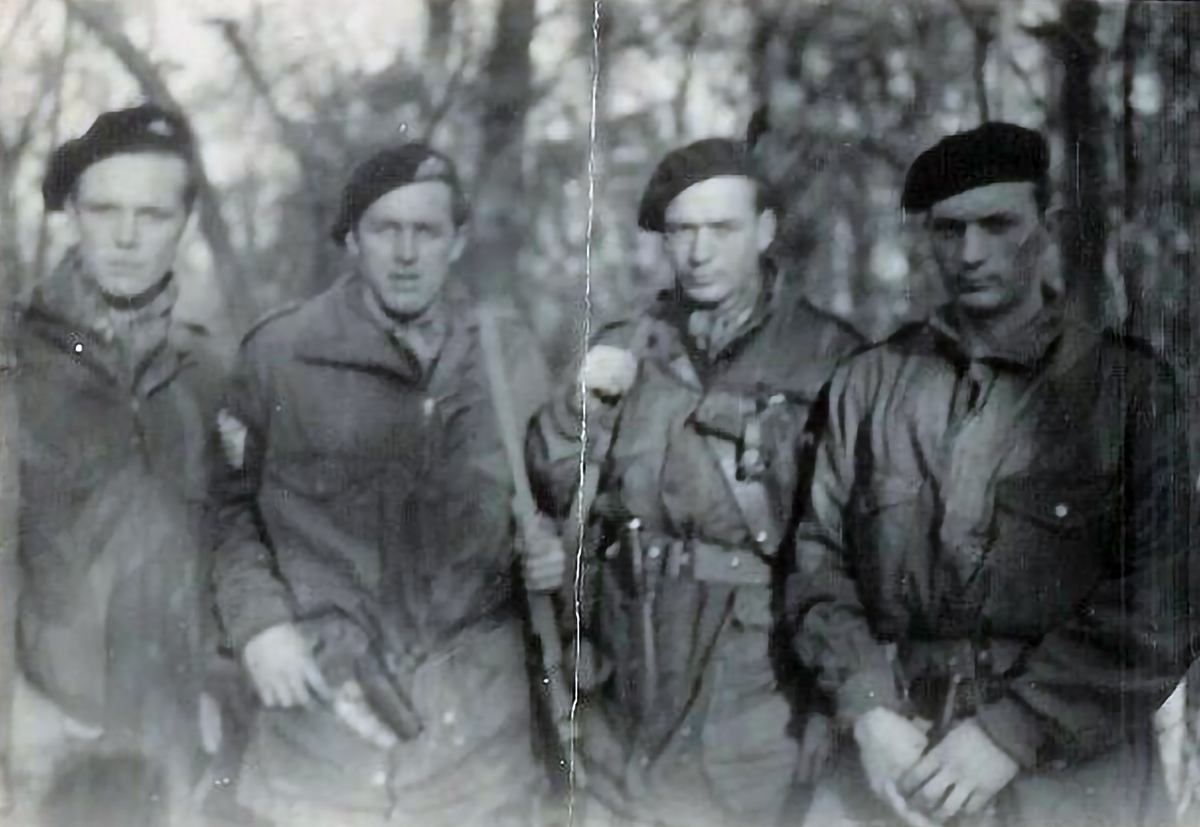
From left: Odd A, Anderson (Christopher Mission 3/4 Sept. 44 and RYPE), Kai O.C. Johansen (Percy Red July 31/ Aug. 1 1944 and RYPE), Leif Eide (Percy Red and China offensive operational to Hanoi French Indochina), Arne Herstad (Percy Red-China offensive). (Photo courtesy Rolf Herstad)
By JOHN W. SHAVER III, MAJ, USA
B.A., Tennessee Technological University, Cookeville, Tennessee, 1979, Office of the Strategic Services: Operational Groups in France During World War II, July-October 1944; Chapter 3, pages 27–39, Tennessee Technological University, Cookeville, Tennessee, 1979. Approved for public release; Fort Leavenworth, Kansas,1993; distribution is unlimited.
Editors Note: From his thesis on the OSS, submitted for his Masters of Military Arts, Maj. John W Shaver III describes the formation of the OGs, where they were used, etc. The actions of 6 of the approximately160 deployed OG teams are described in a report fashion, and we present the action of the first OG to deploy, team Percy Red. Read the full report at https://apps.dtic.mil/sti/pdfs/ADA273051.pdf.
The American OSS and British SAE sent mostly three man “Jedberg” teams that notables such as Aaron Bank (who later stood up the 10th SF Group), Jack Singlaub (who was later a Chief SOG), and [others]served on or led. In contrast the Operational Groups (OGs) were typically 2 -3 officers and 30 enlisted personnel and were designed to be the cadre of the Maquis teams. Both types of teams parachuted behind enemy lines in France and elsewhere, with the OGs obviously providing more additional muscle to the Maquis resistance movement from the get go. The two types of teams would sometimes work together.
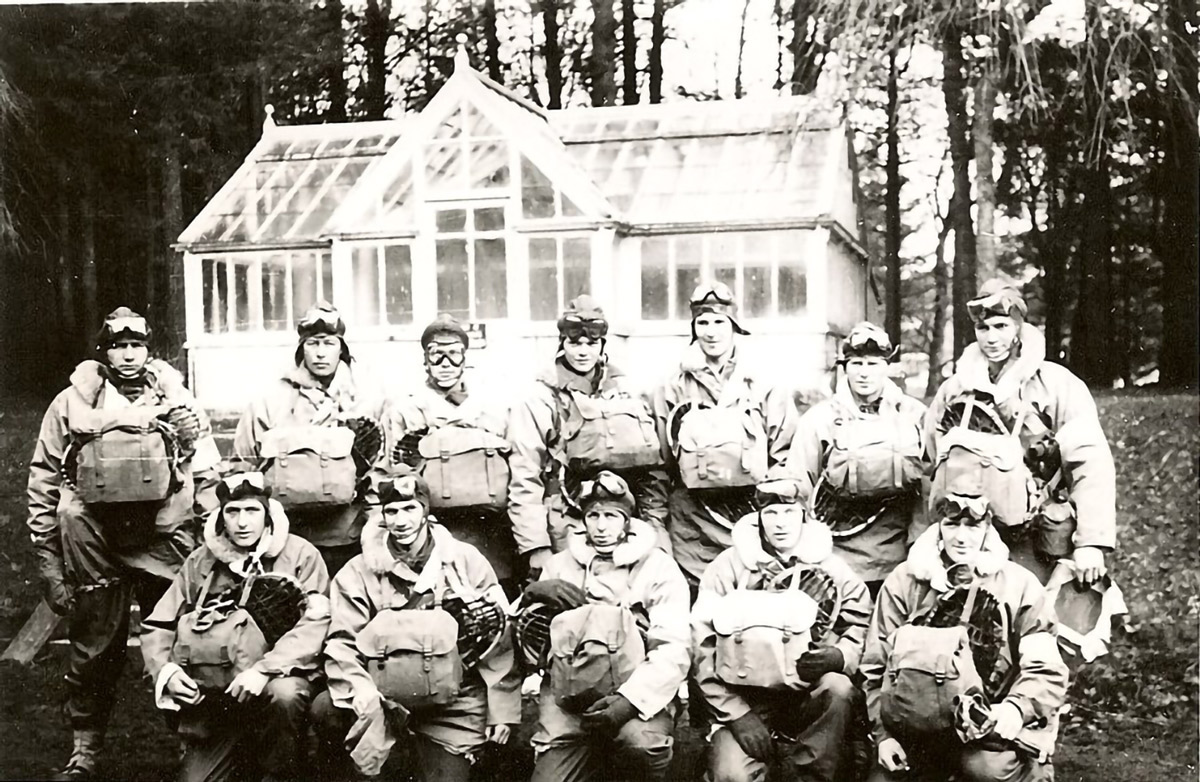
One of the Norwegian OGs in Scotland. (Photo courtesy Rolf Herstad)
CHAPTER THREE
OPERATIONAL GROUP—
PERCY RED
Background
Operational Group “Percy Red,” led by Captain William F. Larson and comprised of 18 men, was the first OG inserted by air drops into France on 31 July and 1 and 5 August 1944 in the Haute Vienne area in central France (see figure 1)1. Its mission was to act as a highly-trained military cadre for the Marquis and assist them in the following tasks:
a. repelling enemy attacks,
b. organizing and carrying out attacks—especially on the Montaubau/Brive/Limoges/Vierzon railway lines,
c. organizing and carrying out attacks on the wolfram mines located at Puy-les-Vignes, near St. Leonard-de-Noblat and Vaulry near Cieux, and
d. providing additional wire/telephone (W/T) communications between EMFFI and the Marquis.2
The Marquis in the areas was led by “Hamlet,” an organizer sent by SFHQ3. There were approximately 5,000 Frenchmen under the control of the Marquis, some with military experience and some with many months of experience employing guerrilla tactics against the Germans. The Marquis were well-armed as a result of a large amount of weapons and ammunition dropped by the Allies since D-day.4
Prior to “Percy Red’s” arrival, the Marquis had carried out successful attacks against railroads, roads, telecommunications and had destroyed two bridges in the area. This prompted the Germans to seek out and attack the Marquis.5
The area was under the control of “Ellipse,” the code name for the French military delegate of the region. “Hamlet” was believed to be in contact with an SAS group in the vicinity, as well as two Jedburgh teams, “Hugh” and “Hamish.”6 The Jedburghs were assisting the Marquis in organizing their resistance and it was probable that the OGs would make contact with them.7
The OGs had one W/T set for each deploying section. They were instructed to use the W/T set from “Hamlet,” while in the Marquis area. If the group was on the move, then they would use their own W/T set and if they broke up, they were to use both W/T’s to contact SFHQ.8
Mission
Four planes took off for the Haute Vienne area in France on a beautiful moonlit night 31 July 1944. Only one plane found the drop zone, while the remaining planes had to drop their personnel later (two planes the next night and one plane on 5 August). First Lieutenant Reider J. Grunseth was in the first plane to drop its load and his group was met on the ground by a reception committee organized by “Hamlet.”9
The air drop did not go very smoothly, with five personnel scattered 500 yards or further away from the drop zone. It took the group four hours to assemble, because of the precautions they took in answering signals. There was a garrison of 200 Germans about ten miles away and they were not sure whether or not the Germans were aware of the drop.10
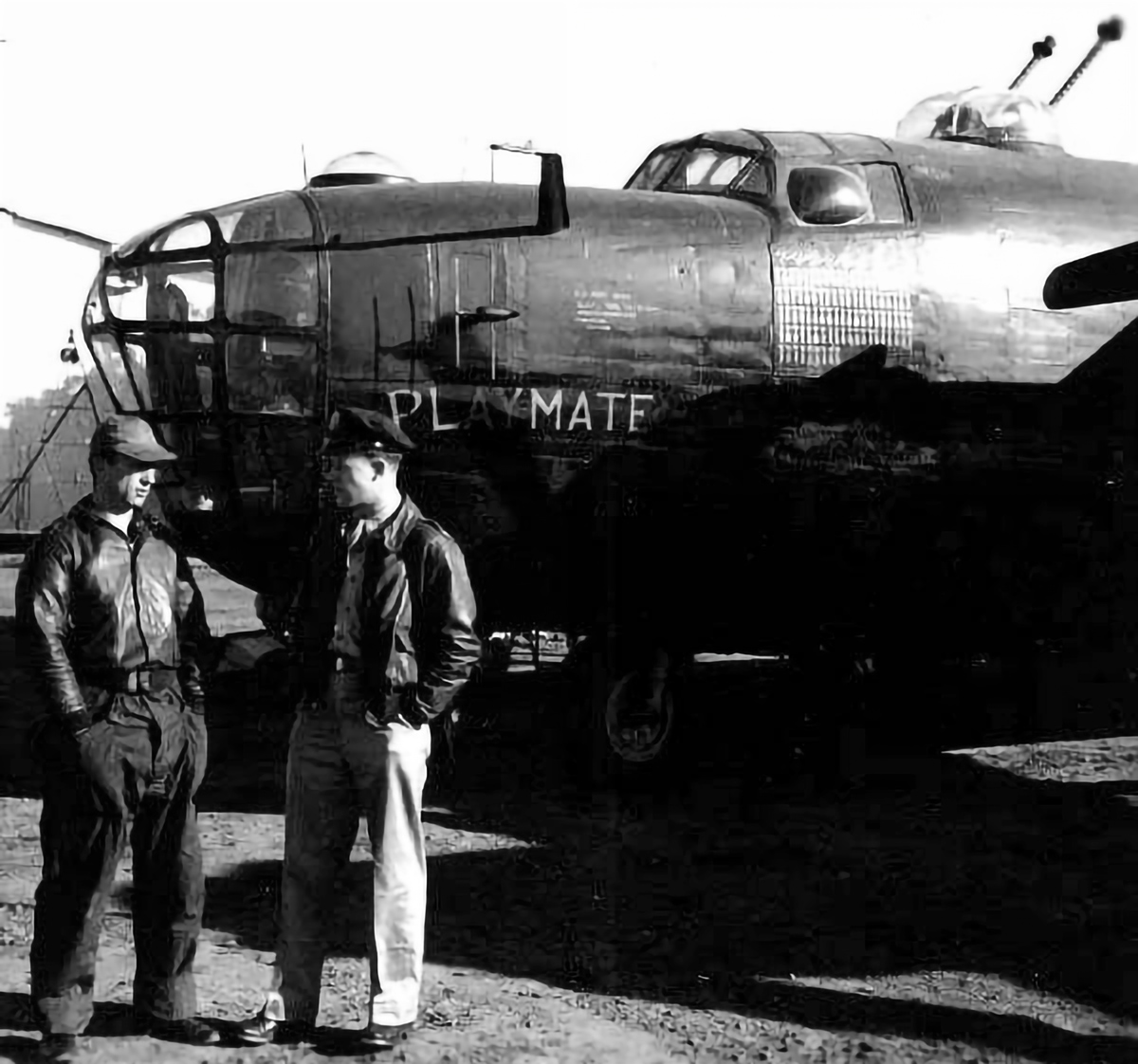
The “Playmate” was the plane that the first five men on Percy Red jumped from on the first night July 31/Aug 1, 1944. Playmate, S# 42-63980, was one of the oldest b-24s in Carpetbagger operations. (Photo courtesy Ben Parnell via Rolf Herstad)
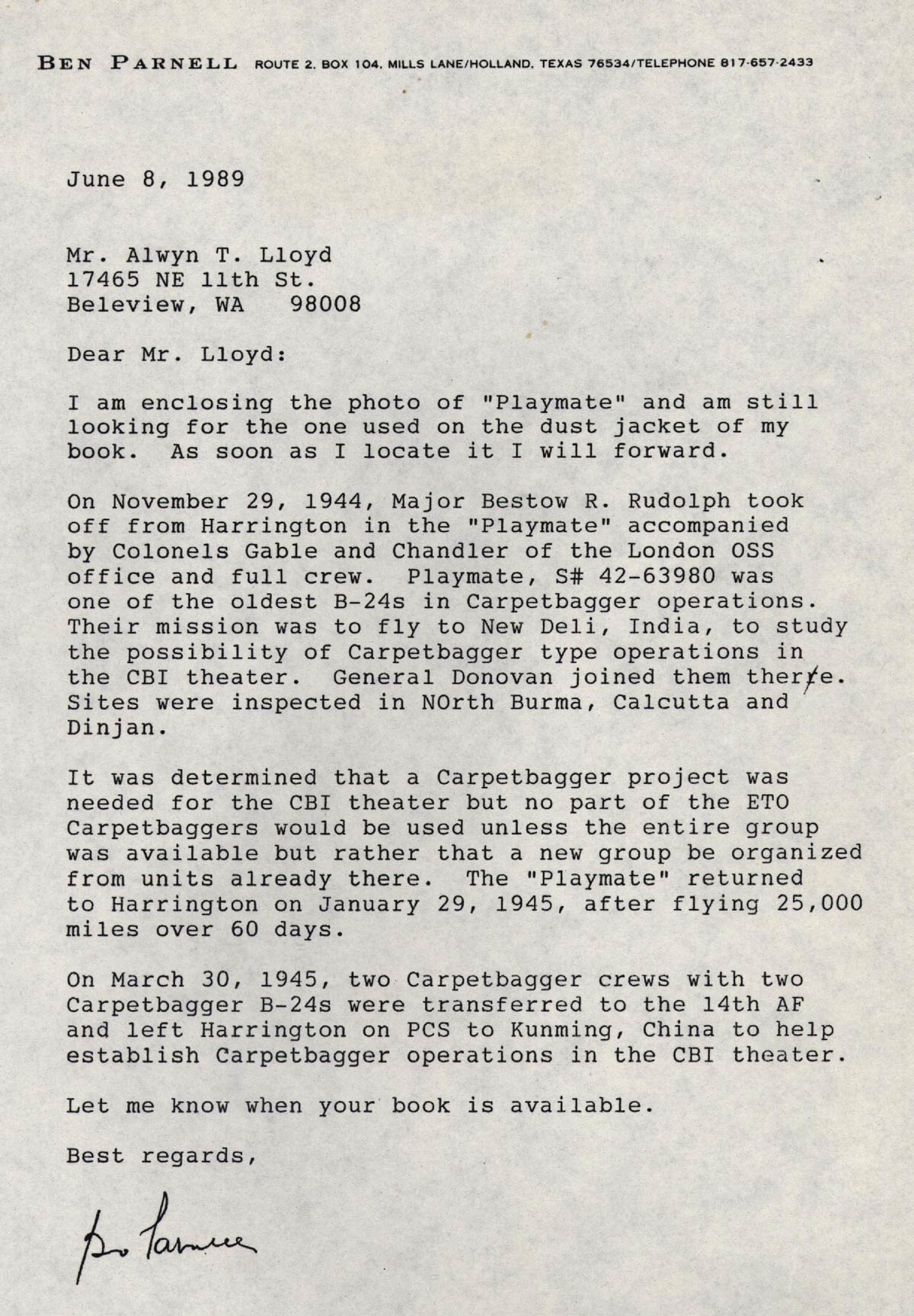
The Marquis took the OGs to a farm for rest and to plan for their first mission. The terrain was rolling and wooded, ideal conditions for Marquis operations. The Marquis was very helpful to the group by supplying intelligence, transportation and assisting them in executing their missions.11 The group was sent to block a national highway and railways and to destroy a wolfram mine near St. Leonard de Noblat. They were to harass the Germans at every opportunity, and with assistance from the Marquis, hinder the enemy’s advance with demolition or sabotage.12
Lieutenant Grunseth’s group remained at the farm house over the next several days and conducted reconnaissance of the area, while awaiting the arrival of the remaining plane loads, when the entire group of 18 men assembled, they moved to a new location between Sussac and La Crousillet.13
At Sussac they established their headquarters. The Marquis conducted many of their activities in this area. While here, Captain Larson received word that the Germans were going to attempt to open the railway with an armored train. The Marquis had kept it closed most of the time, south of Limoges.14 The group found the train the next morning and followed it, waiting for the proper time and place to attack. They planted demolitions ahead of it when it stopped at St. Germaine. The train traveled at about four or five miles an hour with 50 German soldiers on board and one of these positioned in front as a lookout to prevent sabotage. The lookout spotted some electric wires lying across the tracks where the demolitions had been planted and the train halted.15
Meanwhile, the OGs, who had about 40 men comprised of Marquis and several SAS men who had just joined the group, established an ambush along a wooded area adjacent to the tracks and spent the whole night waiting for the train. It was around 8:00 a.m. when the train stopped. The Germans placed sentries around the area. One sentry had the misfortune to discover one of the SAS men. A Marquis man stopped the SAS man from shooting the German, because the group agreed not to initiate the ambush until the demolitions exploded. This allowed the German to warn his comrades. The group returned fire after the Germans began firing their machine guns. The German fire was inaccurate because they could not get a fix on the ambush locations. All at once the Germans were startled when four OG personnel stood up and fired their Bren guns, thus distracting the Germans.16
The group blew up the track as they withdrew, yet the train was about ten meters away from the explosion and was not damaged. The group lost two SAS men captured and their leader, Captain Larson, killed by rifle fire. The Germans returned to Limoges.17
The captured SAS men when questioned by the Germans, informed them there were American and French troops in the area. According to First Lieutenant Grunseth, the group received information after the ambush that approximately 2000 Germans were retreating from Limoges.18
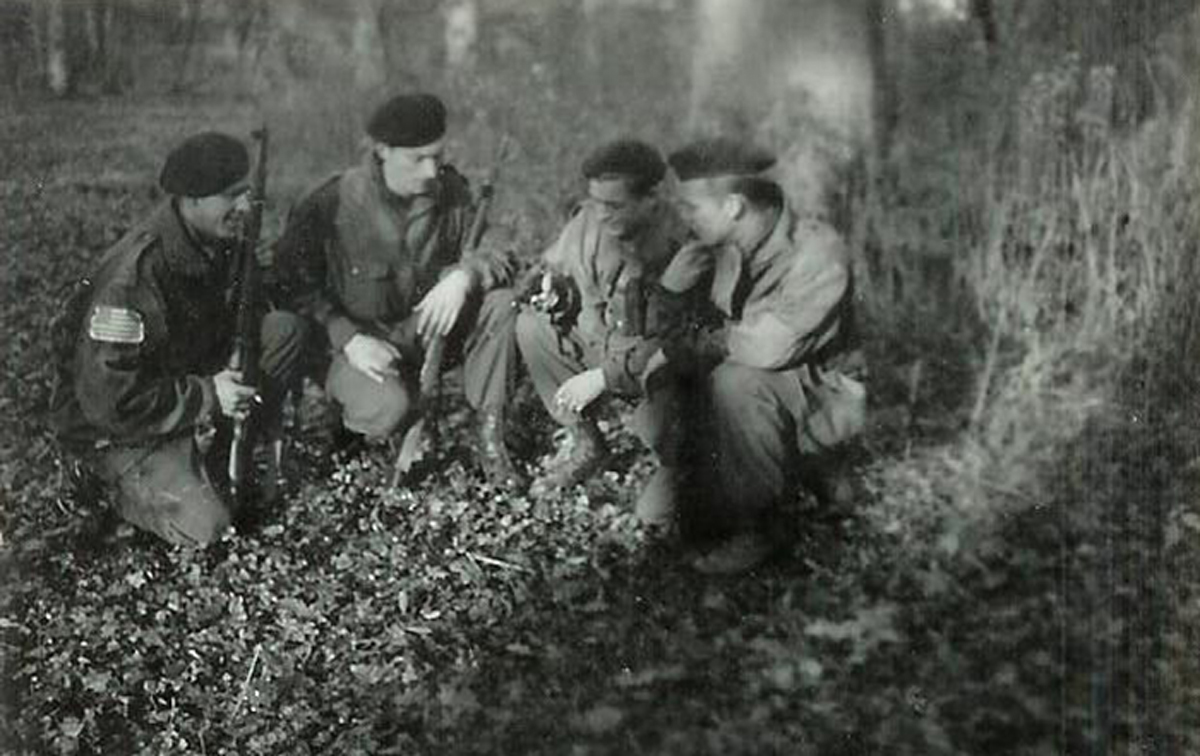
From left, Kai Johansen, Arne Herstad, Leif Eide (with the German Lugar), and the name of the man on far right is unknown. Leif Eide and Arne Herstad served together in OG Percy Red and became life-long friends.
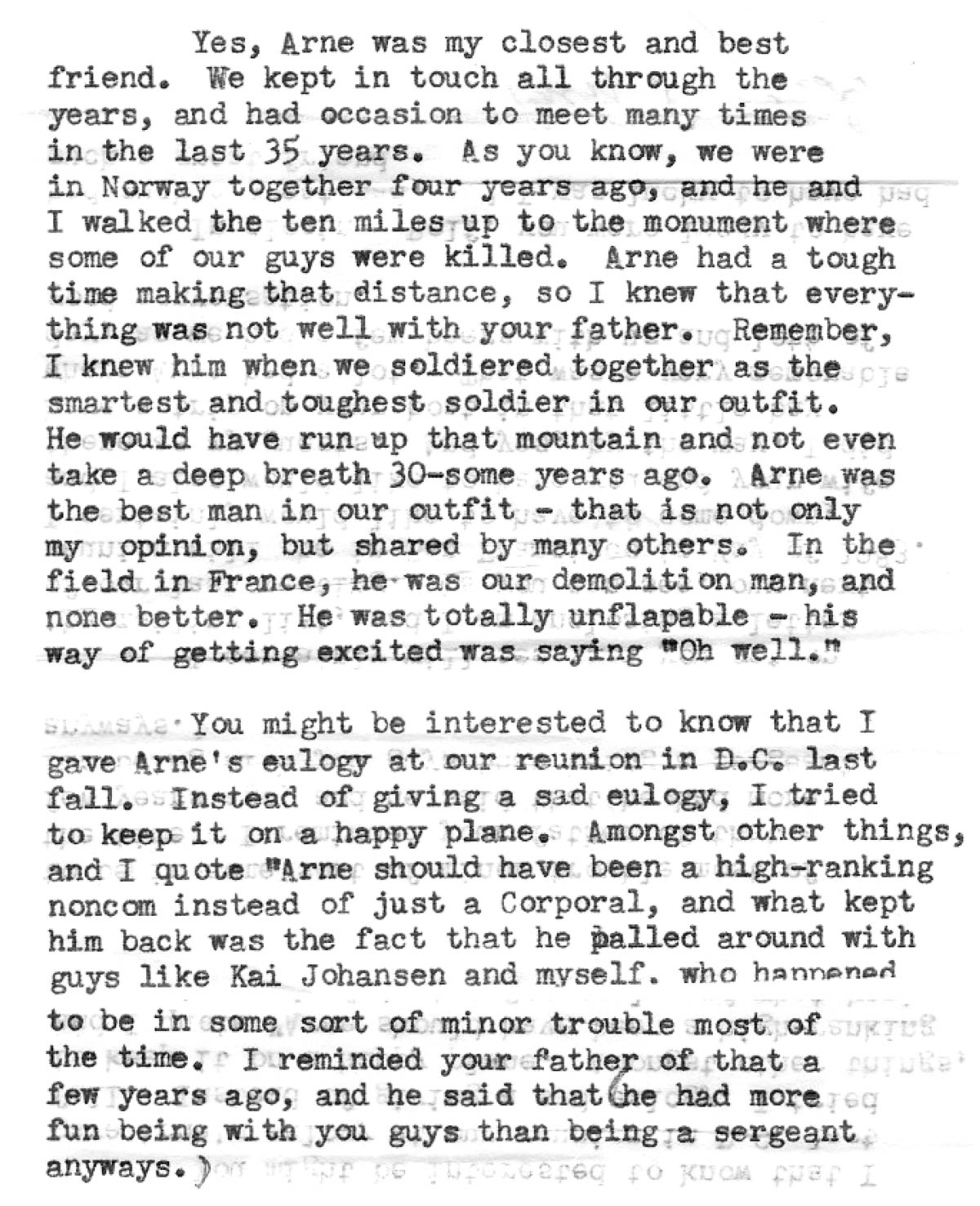
The Marquis were not equipped sufficiently to stop the German withdrawal. The OGs went to St. Leonard to blow a bridge the Germans would have to cross. En route, the group spotted about 200 Germans guarding a wolfram mine just outside of St. Leonard. Fortunately, the bridge was located inside the city and was guarded by French civilians.19
The OGs and Jedburgh team “Lee,” which had joined the group, arranged for the French guards and their families to depart the town.20 Since there were no Germans in the town, the group moved in and began placing demolitions on the bridge.21
The bridge was constructed with railway ties, which made it extremely difficult to place the demolitions on it. The job took about an hour and a half and they were not disturbed by any German patrols from the garrison located about a mile away. The bridge was blown on 13 August with no casualties to the French occupants. The Marquis delayed the withdrawal of the 2000 Germans blocking the road out of Limoges, when they received word about the bridge in St. Leonard.22
The group departed St. Leonard after the demolition. Then a group of 200 Germans from the garrison near St. Leonard moved into the town and warned the civilians they would burn the whole town if the bridge were blown again.23
The OGs began to plan how they would take the German garrison at Limoges. They coordinated for, and received confirmation they would receive air support for their attack against the garrison. Twenty-four hours prior to the attack, the German general at Limoges wanted to discuss terms of a surrender for his forces, while the Allies were discussing terms, the German garrison received orders to withdraw. When the general returned to the garrison, he was arrested by the Gestapo and fighting broke out among the German defenders. Later, when the firing had stopped, the resistance group entered the town and met with German Captain Stoll, who explained what happened inside the garrison. The general had issued orders to surrender when he was arrested and taken away by the Gestapo in a large convoy. Captain Stoll stated he remained to carry out the general’s orders.24
The German convoy had escaped by a road left unguarded. The OGs feared that the remaining Germans in Limoges might attempt another breakout, so they destroyed the national highway about 35 kilometers south of the city. The group, with assistance from the local population, spent the next three days building an anti-tank ditch across the highway. They mined the surrounding terrain, cut down its trees and booby-trapped them with mines. The side roads were booby-trapped and a railroad bridge on a separate road was destroyed to block passage. This also prevented reinforcements coming from the south to assist the Germans at Limoges.25
After completion of this work, “Hamlet” and the OGs arrived at Limoges and arrived in time to celebrate the town’s Liberation. The Germans had departed north for LeBlanc. Upon learning this, the OGs determined they should go west to Chazelle and hinder the Germans trying to escape northeast from Bordeaux. During this action, the Germans recaptured Chateauroux, east of LeBlanc, from the Marquis.26
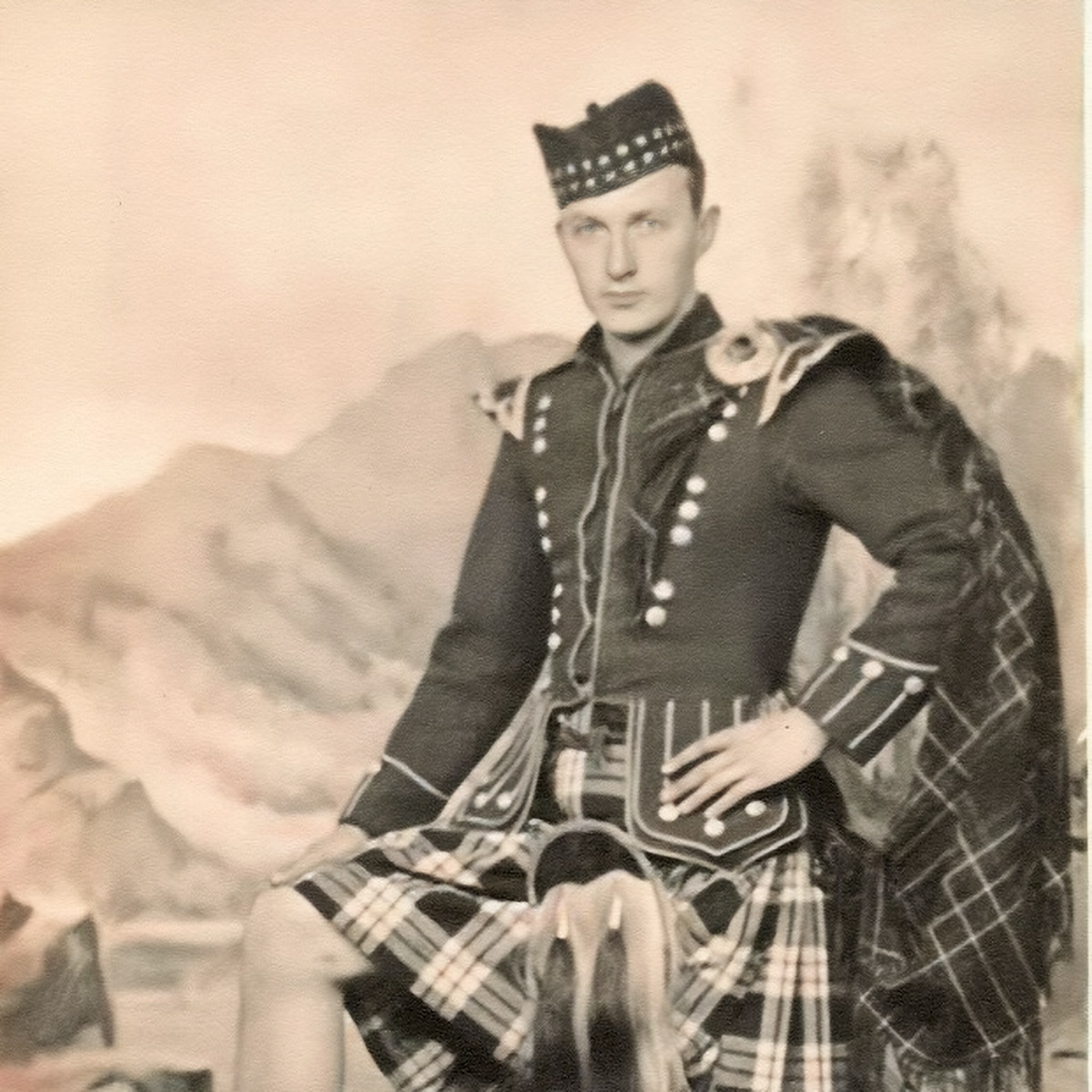
Arne I. Herstad, taken in May of 1944, two weeks before transfer to the operational center Harrington from Scotland—approximately a week before D-day. (Photo courtesy Rolf Herstad)
The OGs found the Marquis at Chazelle bitter, yet they were still welcomed on their arrival. The Marquis had never received any supplies, which accounted for why they felt the way they did. What supplies they had were obtained through containers dropped erroneously in their area. The group stayed there for two days attempting to locate the Germans.
The intelligence from the Marquis was inaccurate, and every lead led to a dead end.27
On 27 August the group moved west to a new area, La Rochefoucauld, where the Marquis provided better intelligence. It appeared the Germans were holding Angoulême, southwest of La Rochefoucauld, as the key pivot for all troops leaving the Bordeaux area and southwest France in general, once the information was confirmed, team “Lee,” SAS and OG “Percy Red” decided to set their own ambushes along national highway 10. Additionally, the group requested bombardment along this road from Angoulême to Ruffec. The group observed a large number of Germans, including horse-drawn artillery. However, the surrounding terrain was too flat to allow an attack on the Germans. Therefore, the group went further south and found better terrain along the highway to conduct operations, while waiting, many trucks passed by marked with the “Red Cross.”28
On 31 August the group split in two with the OGs and Captain Charles E. Brown III, leader of team “Lee” establishing their own ambush at 2100 hours along national highway 10 below the first crossroads south of La Chignolle. The group waited patiently until a ten-truck troop convoy with troops packed like sardines in the back came along. They fired upon the entire convoy. In the confusion, unknown to the OGs, a group of Germans, about 500 meters away with machine guns, opened fire on the ambush site. The group had to withdraw immediately, but surprisingly they took no casualties.29
The group decided to pursue the Germans toward LeBlanc, arriving 3 September. The Germans were strong in the area and a small group occupied a nearby chateau. The OGs attacked the chateau and found eight Germans with a machine gun. They killed two and captured the other six, all wounded (two later died). The Germans had not posted any guards, making it fairly easy for them to be captured.30
After this incident, the OGs received information that 300 German trucks would be moving on the national highway. They decided to try another ambush. They conducted reconnaissance of the area and found a good site in the woods and awaited the arrival of the convoy. However, the group was forced to withdraw from their positions, when about two companies of Germans searched through the woods on both sides of the road prior to the convoy passing. The group returned to LeBlanc and began preparations for their next mission.31
The next day the men located a small German garrison in a nearby town. They attempted to coordinate an attack with the local Marquis. Prior to the attack, an American plane flew overhead, and the group signaled him to strafe the Germans. The Germans returned fire, knocking out the right engine, and the plane crashed. The group was between the plane crash and the Germans. A small group of Germans crossed an open field in the direction of the crash. The OGs set up firing positions with a Bren gun and small arms. All the Germans were killed or wounded; however, there were more Germans in the vicinity and they were much closer to the crash site. The Germans could move under cover, while the OGs and their party had to approach across a relatively open field. Reluctantly, the group withdrew to the east about five miles.32
On 6 September, the group left LeBlanc where the OG “Percy Red” team linked up with OG “Patrick,” commanded by Lieutenant Colonel Obolensky at the Chateau de Verneuil in the Forêt de Lancosne, twelve kilometers southeast of Mézières. OG “Patrick” was working on the highway, so OG “Percy Red” joined them and worked alternate (ambush) shifts. OG “Percy Red” received orders from London to continue working with LTC Obolensky, so “Hamlet” departed for London.33
During the entire operation, both OG teams had lost a lot of weight and their food was not enough to sustain them. The group was exhausted and LTC Obolensky told them to rest when “Percy Red” received orders to return to England. The group went to LeBlanc where they caught a C-47 back to London on the morning of 10 September.34
Endnotes
1. The members of Group Percy Red were as follows: Captain William F. Larson, Inf., code name “Leander,” (the leader, killed in action 11 August 1944 by a grenade), Captain (then 1st Lieutenant) Reider J. Grunseth, Inf., code name “Gerbert” (2nd in command, slightly injured in action on 1 September 1944 suffering a dislocated left shoulder during a withdrawal from German forces), S/Sgt John Halvorsen, S/Sgt Knut Joa, T/3 Fred Johnson, Col Olaf Aanonsen, Cpl Kai O. C. Johanson (slightly injured in action on 2 August 1944 during parachute drop, when he suffered a severe knee sprain in his right leg, incapacitated for three days and limped for about a week and a half), Cpl Karl Larsen, T/5 Sverre Aanonsen, T/5 Olav Bide, T/5 Arne Herstad, T/5 Louis D. Brie, T/5 Marinus D. Myrland, second W/T operator, code name “Mateo,” T/5 Alk Paulson, T/5 Oddberg Stiansen, T/5 Otto Twingley, Pfc Delphis Bonin (slightly injured in action on 7 August 1944 suffering a broken left shoulder when a car in which he was traveling turned over; and a broken right wrist on 14 August when he jumped from a truck because of a German ambush; he received aid only from the medical sergeant of the group), PVT Leif Eide, first W/T operator, code name “Edgar.” John Mendelsohn, Covert Warfare: Other OSS Teams, Volume 5, 18 Volumes, (New York: Garland Publishing Company, 1988), (Volume 4-A), Jan.-Jun. 44, p. 22; OSS/London: Special Operations Branch and Secret Intelligence Branch War Diaries (Microfilm, Frederick, MD: University Publications of America, 1985), Volume 13, Jan.-Dec. 44, Casualties, p. 3, 17-19. click to return
2. Mendelsohn, Volume 4-A, Jan.-Jun. 44, p. 23-24. click to return
3. Hamlet was the code name for an SOE agent and organizer of the “Salesman” circuit (operation). Hamlet’s targets were the following:
Railways:
Lines at Vierzon
Bourges–St. Florentin
St. Florentin–Issoudun
Limoges—Le Palais
Saillat Chassenon—Rochechouart
Perigueux—Thivier
Perigueux—Mussidan
Lines converging on Bergerao Pierre Vuffiere—Uzerche
Roads
Perigueux: Route N 21 Periguex – Beynac
Route N 139 Perigueux – Angouleme – Limoges
Limoges: Route N 141 Angouleme – Limoges/Aubusson
Route N 20 Chateauroux – Limoges – Uzerche
Telephones: Lines converging on Limoges and Chateauroux
Power lines at Eguzon
OSS/London, Volume 3, Apr.–Jun. 1944, Western Europe, p. 249-250. click to return
4. Mendelsohn, Volume 4-A, Jan.-Jun. 44, p. 23. click to return
5. Ibid. click to return
6. Team “Hugh” was the first Jedburgh team dispatched to France from England. Its primary mission was to assist SAS in the establishment of their base, which would be reinforced by additional SAS troops from which raids were to be carried out on the German lines of communications. Mendelsohn, Volume 4, Apr.-Jun. 44, Jedburghs, p. 17-18. Jedburgh team “Hamish” was the fifth team dispatched to France. Its primary mission was to assist team “Hugh” in the organization of new resistance elements and the establishment of an SAS base. The team was to focus on forming separate groups of about 100-200 men. Mendelsohn, Volume 4, p. 46-47. click to return
7. Mendelsohn, Volume 4-A, p. 24. click to return
8. Ibid. click to return
9. Ibid., p. 26. click to return
10. Ibid. click to return
11. Ibid., p. 27. click to return
12. Ibid. click to return
13. Ibid. click to return
14. Ibid., p. 27-28. click to return
15. Ibid., p. 28. click to return
16. Ibid., p. 28-29. click to return
17. Ibid., official records state Captain Larson was killed by a grenade explosion, captain Grunseth reported this as the cause of death. However, Leif Eide was with Captain Larson in the ambush site and saw him killed by rifle fire. OSS/London, Volume 13. Jan.-Dec. 44, Casualties, p. 3; Record Group 226, G3 Reports 10-111 and HA, Entry 99, Folder 56, Box #13, G-3 Periodic Report No. 72; and Leif Eide, interview with the author, 12 March 1993. click to return
18. Mendelsohn, Vol. 4-A, p. 29; and Vol. 4 Jedburghs, p. 692. click to return
19. Mendelsohn, Vol. 4-A, p. 29. click to return
20. Jedburgh team “Lee” was the 23rd team dispatched along with an SAS group to France. Its mission was to work with “Salesman” in the Haute Vienne region. Mendelsohn, Volume 4, Jedburghs, p. 683. click to return
21. Mendelsohn, Vol. 4-A, p. 30 and Vol. 4, p. 692-693. click to return
22. Ibid., and Record Group 226, G3 Reports 10-111, G-3 Periodic report No. 74. click to return
23. Mendelsohn, Vol. 4-A, p. 30-31. click to return
24. Ibid., p. 31; The total number of Germans under Captain Stoll taken as prisoners was 341 (12 officers, 65 German soldiers and 264 Russians in German uniforms). Mendelsohn, Vol. 4, Jedburghs, p. 693-696; Hilary Footlit, France 1943-45, (New York: Holmes and Meier, 1988), p. 101. click to return
25. Mendelsohn, Vol. 4-A, p. 31 and Vol. 4 Jedburghs, p. 699. click to return
26. Mendelsohn, Vol. 4-A, p. 31 and Vol. 4 Jedburghs, p. 699. click to return
27. Mendelsohn, Vol 4-A, p. 32. click to return
28. Ibid., and Vol. 4, p. 700. click to return
29. Mendelsohn, Vol. 4-A, p. 32-33. The group learned the following day that Angouleme had been liberated and they had apparently attached the last convoy to leave the city. Mendelsohn, Vol. 4, p. 700-702. click to return
30. The captured prisoners were a misfit group: one marine, one anti-aircraft man, and name infantry men. The group had observed that the Germans’ retreat was very well organized up front, but the rear guard was not organized at all. According to First Lieutenant Grunseth, the “prisoners had good stocks of cognac, cigarettes and other supplies. It seemed to be every man for himself.” Mendelsohn, Volume 4-A, p. 33 and Volume 4, p. 702-703. click to return
31. Ibid., p. 34 and p. 703-704. click to return
32. The plane was destroyed by fire and there was no information of survivors. Ibid., p. 34 and p. 704. click to return
33. OG “Patrick” was the fifth group dropped France, comprised of 25 men. Its mission will be discussed in Chapter 6 of this paper. Ibid., p. 34-35 and p. 704-705. click to return
34. Mendelsohn, Vol. 4-A, p. 35. click to return
[…] OSS OGs – Operational Group – Percy Red. This OG, comprised of 18 men, was the first one to be air dropped into France in the summer of 1944. Its mission was to act as a highly-trained military cadre for the French Marquis and assist them in conducting attacks on the Germans in occupied-France. Article in the May 2025 issue of Sentinel.https://www.specialforces78.com/oss-ogs/ […]